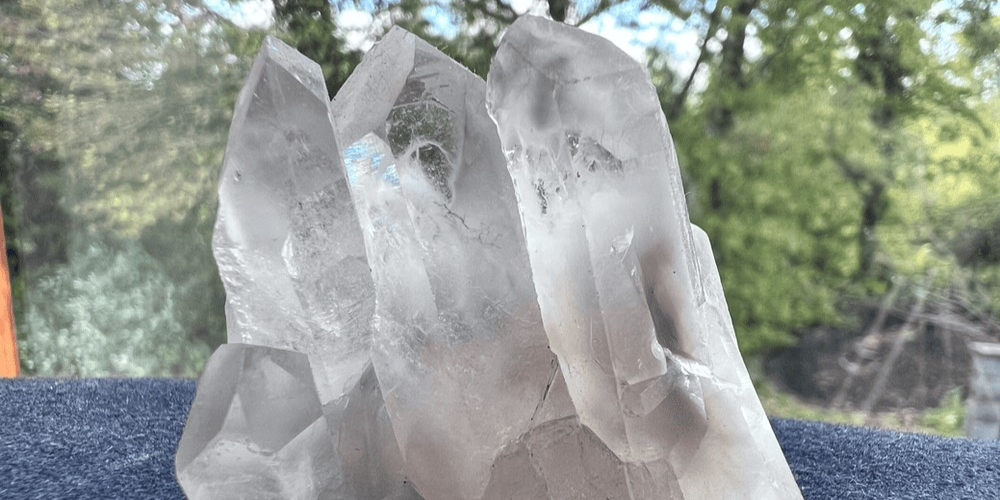Natural crystal is a crystalline body of the mineral Quartz, chemically composed of silica (SiO₂), which is formed through a long natural process under specific geological conditions. It is usually formed by the orderly arrangement of silicon atoms and oxygen atoms in a siliceous solution-rich environment with high temperature, high pressure and siliceous solution in the underground area, and gradually crystallized and grown. For example, in some volcanic areas or rock fissures, silica-rich hydrothermal fluids slowly cool and precipitate, eventually forming natural crystal crystals over thousands of years or more.
Physical
Optical properties: It has the phenomenon of double refringence, that is, when the light passes through the natural crystal, it will be decomposed into two refracted rays, which makes the natural crystal have a certain application value in the field of optical instruments. At the same time, its refractive index is relatively stable, between 1.544 – 1.553, and the refractive index of natural crystals of different colors and origins will be slightly different, which can be used as one of the important identification bases in the field of gem identification. Crystal Type
Appearance: Natural crystal crystals have regular geometric shapes, common columnar, rhombohedral shapes, etc., and the crystal surface is usually relatively smooth, with natural crystal luster. They vary widely in size, from small ones that can be as small as a few millimeters to large ones that can be several meters long, although large, high-quality natural crystals are rare. For example, in some crystal mines, people can find natural crystal clusters of various shapes and sizes, which grow together to form a spectacular scene.
Transparency and luster: generally with high transparency, some are as clear as water, and some may be slightly hazy due to impurities and other factors. Its luster belongs to the glass luster, which can reflect bright light under the illumination of light, and looks crystal clear and very textured. Like high-quality natural white crystal, it is extremely transparent, and looks like pure ice cubes when viewed to light.
Hardness: The Mohs hardness is about 7, which is relatively hard, and can easily leave scratches on minerals with lower hardness such as gypsum and calcite, but it can also be scratched by harder substances such as diamonds and corundum. For example, if you cut glass with natural crystal, there will be obvious scratches on the surface of the glass, but the crystal itself will not be damaged, which is also an easy way to identify natural crystal (although it needs to be distinguished from other materials of similar hardness).
Density: The density is around 2.65 grams per cubic centimeter, which may fluctuate slightly depending on the impurities contained inside. By measuring the density, it can be used to determine whether it is a natural crystal to a certain extent, but this method requires more accurate measuring instruments and a comprehensive judgment in combination with other identification methods.

Color variety
Green Quartz: Relatively rare, its color formation may be related to the presence of trace amounts of chromium (Cr) and other elements, showing a fresh green color, but many so-called green crystals on the market may have been artificially irradiated and other treatments, which need to be carefully identified. Natural green crystals can be used to make some unique jewelry that shows off the beauty of nature like no other.
Colorless crystal (White or Clear Crystal): also known as white crystal, is the most common type of natural crystal, pure and transparent, almost free of impurities and color-causing elements, often used to make crystal jewelry basic materials, or processed into a variety of crystal handicrafts, such as white crystal carved Buddha statues, zodiac ornaments are more common in the market, because of its pure and elegant appearance, very popular with people.
Purple crystal (Amethyst): Because it contains trace amounts of iron (Fe), manganese (Mn) and other impurity elements, it presents different shades of purple, ranging in color from light purple to dark violet, and is often called amethyst. Amethyst is widely used in the field of jewelry, can be made into necklaces, bracelets, rings and other jewelry, its mysterious and elegant purple gives the jewelry a unique beauty, favored by consumers, such as the famous Uruguayan amethyst, rich and bright color, high quality, is a high-quality variety of amethyst.
Yellow crystal (Citrine): Mainly due to the presence of iron (Fe), it exhibits a color ranging from light yellow to golden yellow, and is also called citrine. Citrine is often regarded as a symbol of wealth in the market, so it is used more in commercial jewelry, such as ornaments made into fortune or citrine jewelry to wear, among which Brazilian citrine is famous for its bright color and transparent crystals.
Pink crystal (Rose Quartz): Because it contains trace amounts of titanium (Ti), iron (Fe) and other elements, it shows a soft pink color, also known as pink quartz or hibiscus stone. It is often given the meaning of love, and is a popular material for making couples’ jewelry and women’s jewelry, such as pink quartz bracelets, etc., because of its pink color gives people a warm and romantic feeling, and is very popular with young women.
Smoky Quartz: It contains traces of aluminum (Al), lithium (Li) and other elements, which make the crystal show a smoky gray hue from light brown to dark black, and the appearance looks as if it has been smoked, hence the name. Smoke crystal is often used to make some jewelry or handicrafts with a simple and calm style, such as smoky quartz carved seals, etc., which have a unique charm.

Crystal
- Crystal Overview
- The growth environment of crystals
- Understanding Crystal Clarity
- How to identify different grades of crystals
Crystal Crafts
- Crystal Crafts Meaning
- The effect of crystal crafts
- Crystal Crafts Customer Identification Method
- Precautions for maintenance and cleaning of crystal crafts